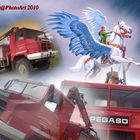Pegaso
En la mitología griega Pegaso era un caballo alado. Pegaso nació de la sangre derramada por Medusa cuando Perseo le cortó la cabeza. Suele representarse en blanco o negro y tiene dos alas que le permiten volar. Una característica de su vuelo es que cuando lo realiza, mueve las patas como si en realidad estuviera corriendo por el aire.
Según las fuentes clásicas, Perseo no llegó a volar montado a Pegaso, puesto que lo hacía gracias a unas sandalias aladas, sin embargo, muchos artistas renacentistas lo representaron volando en este caballo.
Pegaso aparece relacionado fundamentalmente con el héroe Belerofonte, quien a lomos del équido alado logró dar muerte a la Quimera, una bestia de múltiples cabezas (entre ellas una de león y otra de cabra) que asolaba los territorios de Licia. Gracias a este corcel Belerofonte pudo obtener igualmente una victoria sobre las amazonas. Belerofonte encarna el "defecto" de la "excesiva" ambición. Cuando por fin consigue montar a Pegaso, no contento con esto le obliga a llevarlo al Olimpo para convertirse en un dios, pero Zeus, molesto por su osadía, envía a un insignificante mosquito que pica el lomo de Pegaso y precipita al vacío a Belerofonte sin matarlo, quedando lisiado y condenado a vagar apartado del resto del mundo toda su vida recordando su gloria pasada.
La leyenda de Pegaso puede haber influido la formación de la figura del buraq en la tradición islámica. Es uno de los equinos más célebres de la literatura junto con Rocinante (caballo de Don Quijote de la Mancha), Babieca (el de El Cid), Bucéfalo (el de Alejandro Magno) y el caballo de Troya, entre otros.
Los camiones Pegaso, continuadores de la tradición iniciada con la fábrica Hispano Suiza, están íntimamente relacionados con la evolución del transporte de mercancías y colectivo de personas en España. Eran camiones con una potencia muy ajustada pero que se adecuaban a las necesidades y las carreteras existentes. Los modelos fueron diseñados íntegramente en España y se han mantenido hasta hoy con la evolución necesaria adecuada a los tiempos. Las fábricas eran del INI, el organismo que agrupaba las empresas públicas, y finalmente fueron privatizadas. Sus factorías terminaron fabricando camiones Iveco.
------------------------------------------------------------------------------------------------------
In Greek mythology, Pegasus, was a winged horse. Pegasus was born from the blood of Medusa when Perseus cut off her head. Usually represented in white or black and has two wings that allow you to fly. A feature of his flight is that when performed, move your legs as if they were running through the air.
According to classical sources, never flew Perseus riding Pegasus, as it did thanks to winged sandals, however, many Renaissance artists represented him flying in this horse.
Pegasus appears primarily concerned with the hero Bellerophon, who backs the winged equine managed to kill the Chimera, a beast of many heads (including a lion and a goat) that was ravaging the territories of Lycia. Thanks to this horse Bellerophon could also obtain a victory over the Amazons. Bellerophon embodies the "defect" of the "excessive" ambition. When I finally get to ride Pegasus, not content with so he had to take him to Olympus to become a god, but Zeus, angry at his audacity, sent to a small mosquito that stings the back of Pegasus and Bellerophon precipitates vacuum without kill him, being crippled and condemned to wander off from the rest of the world all his life remembering its past glory.
The legend of Pegasus may have influenced the formation of the figure of Buraq in Islamic tradition. One of the most famous horses of the literature along with Rocinante (Don Quixote's horse of La Mancha), Babieca (El Cid), Bucephalus (that of Alexander the Great) and the Trojan Horse, among others.
Pegaso trucks, followers of the tradition started with the Hispano Suiza factory, are closely related to the evolution of collective goods and people in Spain. Trucks were very tight power but that suited the needs and existing roads. The models were designed entirely in Spain and have remained to this day with appropriate changes to the times required. Factories were the INI, the body that brought together public companies, and were finally privatized. Its factories ended up producing Iveco trucks.










SeraPhotoArt 31/03/2012 20:49
Gracias Antonio saludosantonio naranjo ojeda 31/03/2012 15:28
excelente trabajo buen dominio del PS saludos